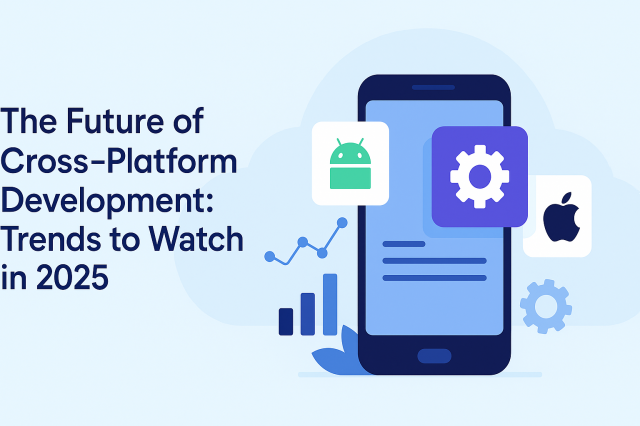In the fast-paced world of mobile app development, staying ahead of the curve is crucial for businesses, developers, and tech enthusiasts alike. As we move deeper into 2025, cross-platform app development is emerging as a dominant force, reshaping how we build, deliver, and experience applications. This blog explores the key trends driving the future of app development and why cross-platform solutions are more relevant than ever.
Why Cross-Platform Development Matters
Cross-platform app development allows developers to write code once and deploy it across multiple platforms most notably iOS and Android. This not only saves time and resources but also ensures a consistent user experience. As the demand for mobile apps continues to surge across industries—from e-commerce and healthcare to education and entertainment developers are increasingly turning to frameworks like Flutter, React Native, and Xamarin to meet user expectations efficiently.
In 2025, cross-platform development is no longer just a cost-saving alternative; it's becoming the industry standard.
Trend #1: AI-Powered Development Tools
One of the most exciting mobile app trends in 2025 is the integration of artificial intelligence (AI) into development tools. AI is now assisting developers in writing better code, debugging faster, and optimizing performance. AI-powered IDEs and code assistants like GitHub Copilot are evolving rapidly, providing real-time suggestions and error-checking that streamline the development process.
In cross-platform environments, this means faster deployment cycles and more stable apps. As AI continues to learn from massive datasets, the quality of suggestions and code generation will only improve, making app development more efficient and accessible—even for those with limited programming experience.
Trend #2: Flutter 4 and React Native Evolution
Flutter and React Native remain at the forefront of cross-platform app development in 2025. Flutter 4, released earlier this year, has introduced enhanced rendering engines, native UI components, and reduced latency for animations. React Native has also made strides with better TypeScript support, faster builds, and improved developer tooling.
These advancements mean that cross-platform apps now rival native apps in terms of performance and user experience. The gap between native and cross-platform continues to close, and in many cases, cross-platform apps are outperforming their native counterparts due to easier maintenance and quicker updates.
Trend #3: Super Apps and Modular Development
Another major shift in the future of app development is the rise of super apps applications that combine multiple services under one roof. Think of platforms like WeChat or Grab, which allow users to chat, shop, pay bills, and more, all within a single interface.
To support these complex ecosystems, developers are leaning heavily on modular architecture. Cross-platform frameworks are adapting to support microservices and modular components that can be developed independently and integrated seamlessly. This not only simplifies the maintenance of large-scale applications but also supports continuous deployment and scalability.
Trend #4: Cloud Integration and Edge Computing
In 2025, mobile apps are no longer confined to the limitations of local storage or computing power. Cloud integration has become essential, allowing apps to sync data across devices, perform heavy computations, and store vast amounts of information securely.
Cross-platform frameworks are now offering better tools for cloud integration, enabling seamless connections with platforms like AWS, Firebase, and Azure. Additionally, edge computing is reducing latency by processing data closer to the user. This trend is particularly impactful for real-time applications like gaming, video streaming, and IoT.
Trend #5: Enhanced Security Protocols
With data privacy and cybersecurity becoming top concerns, app developers are prioritizing security like never before. In 2025, cross-platform frameworks are incorporating more robust security features out of the box such as biometric authentication, end-to-end encryption, and secure APIs.
Cross-platform tools are also supporting compliance with regulations like GDPR and CCPA more effectively, allowing developers to meet legal requirements without significant overhead. These built-in protections make cross-platform apps not only faster and more cost-effective but also safer for users.
Trend #6: Focus on Accessibility and Inclusive Design
As digital inclusivity becomes a mainstream priority, developers are being called to design apps that are accessible to all users, including those with disabilities. Cross-platform tools are keeping up with this demand by integrating accessibility testing tools, screen reader compatibility, and flexible UI components.
In 2025, apps that ignore accessibility are at risk of being left behind both by users and by app stores. The future of app development hinges on inclusivity, and cross-platform frameworks are playing a vital role in democratizing app access for everyone.
Final Thoughts: The Cross-Platform Future is Here
The landscape of mobile app trends in 2025 is dynamic and full of potential. Cross-platform app development has moved beyond its early limitations and is now the backbone of efficient, scalable, and user-friendly applications.
Whether you're a startup looking to launch your MVP or an enterprise aiming to streamline your digital services, investing in cross-platform development is a smart move. With powerful frameworks, AI-driven tools, cloud connectivity, and enhanced security, the future of app development is not only cross-platform it's faster, smarter, and more inclusive than ever before.






